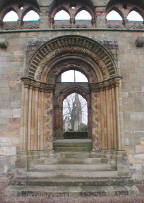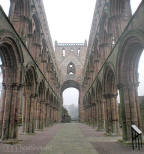|





Augustinian
Founded 1138 by David I BLACK Canons of the Augustinian Order came to found a priory at Jedburgh
in place of a church which had been there since at least the 9th century.
Since the Celtic Church had a policy of building on sites of previous
religious significance, Jedburgh may have been a place of worship for many
centuries before that.
The priory was very soon promoted to an abbey, which brought power and
influence with it. Alexander III was married at the abbey in 1285.
During the early years of the Wars of Independence Jedburgh was held to be
pro-English. Edward I stayed there during his campaign of 1296, and
elected an abbot sympathetic to his cause. As Robert Bruce strengthened
his hold on the nation Abbot William and 11 canons were forced to flee to
Yorkshire, while the new abbot, Kennock, is credited with keeping peace in
the area for the next decade through the power of prayer alone.
Jedburgh Castle was destroyed in an English raid of 1409, during which the
abbey was also fired. The complex was raided another three times in the
following 55 years then again in 1523.
During the Rough Wooing of the 1540s the abbey was held by the English and
used as a base for raiding until an Auld Alliance army re-took it in 1548
and fortified it against future attacks. Another devastating raid all but
destroyed the abbey in 1555.
In 1604, with all canons gone, the abbey was secularised and much of the
masonry was gradually absorbed into local buildings. The power of the Jed
Water at the south of the complex was utilised by commercial mills, some
of which continued in business until the 1960s.
Finally, in 1875 the Marquis of Lothian built a new parish church outside
the abbey precinct and set about removing all post-Reformation work from
the ruins. the result, given to the nation in 1913, is an almost complete
medieval church preserved for all time.
This text is abbreviated from the articles
that appear on ScotlandPast's CD-Rom digital guide "The Border Abbeys".
The guide also features 360 degree panoramic images, photo galleries,
video introductions, 3D interactive graphics and an at-a-glance history
timeline. The CD, which runs on PC and Mac with most Internet browsers, is
available for £8.99 from
http://www.scotland-past.com ©2003 ScotlandPast. All rights reserved. |

